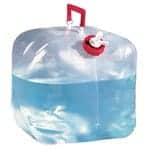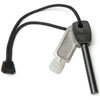There have been a lot of shows popping up lately focusing on how a lot of people are preparing for end of the world doomsday scenarios, natural disasters and other emergencies.
A couple of the shows that I’ve seen recently include Doomsday Preppers on the National Geographic channel and Doomsday Bunkers on the Discovery Channel.
Here’s a quick look at the trailer for the Doomsday Preppers show to give you an idea what it’s about.
As you can tell from the video, a lot of these people are pretty serious about preparing for emergency situations, many taking their “prepping” to extremes by building bunkers that costs hundreds of thousands of dollars, stocking up on thousands of dollars worth of food, water, guns, ammo and other provisions.
In my opinion a lot of these folks are taking things a bit too far, preparing for eventualities that aren’t very likely to happen. Total world nuclear war? Doubtful. Zombie apocolypse? Not likely.
While I don’t think our family will be going to the extremes seen on the videos, I still think it can be a good idea to have a personal emergency preparedness plan in place for more likely scenarios. If something like a natural disaster (think tornado, earthquake or hurricane) were to hit your area, would you be able to hold out for a few days while help was on the way?
Remember, even in this day and age help was slow in coming for disasters like Hurricane Katrina or the Haiti earthquake, and you could be on your own without aid for a few days or even longer. What would you do in that type of a situation? Would you be prepared?
What Is A Bug Out Bag?
One thing a lot of people suggest putting together in case of an emergency is a so-called “bug-out bag” or BOB. What is a bug-out bag? From Wikipedia:
A bug-out bag is a portable kit that contains the items one would require to survive for seventy-two hours when evacuating from a disaster. It is also known as a 72-hour kit, a grab bag, a battle box, and other popular names include “Personal Emergency Relocation Kits” (PERKs) GO Bag and GOOD (Get Out Of Dodge) bag.
In other words, a bug-out bag is a survival kit you put together in order to help you get by with the basics for at least 72 hours, possibly longer, if a natural disaster or other emergency were to hit your area.
Bug Out Bag Essentials List
So what would you want to put in your bug-out bag? After scouring a bunch of survival and disaster preparedness websites that talk about these bug-out bags, here are some things many of them suggest including.
The bug-out bag itself: The backpack doesn’t have to be anything special necessarily, but a good backpacking or hiking backpack or ALICE pack would probably work well for most folks. Just make sure you can fit all the essentials in there, and can comfortably carry it. For a more basic bug-out setup, some people recommend a tactical or cargo type vest instead, but space would be more limited.
- Food rations: For food I’d recommend something like freeze-dried backpacking meals because they’re light and easy to pack. We like the ones from Mountain House, like this 72-hour meal kit that have a 7 year shelf life. Just add water.
- Water: There are a lot of ways to put together water rations for your bug out bag. One way suggested to me is to buy emergency water ration pouches that are good for 5 years and can be found at Amazon or other survival outfitters. The one linked would give you enough water for 72 hours for one person – so you’d have to buy one for each person in your party. Beyond water pouches you could also do bottled water, although you’d have to rotate your water out more often, like every 6 months.
- Water containers: Get something like these 3 gallon water containers and fill them with water. Water will become extremely important, so if you are able to leave in a car or have room, bring extra containers filled with water like this. If portability is more key and you want to fill on the go, you can also bring a collapsible water container. If you want you can use a canteens or water bottles to carry water with you.
Water filter or purification tablets: In case you’re not planning on bringing a lot of water with you, or can’t, it’s a good idea to have a water filter of some sort, and/or iodine water purification tablets. That way you can fill your extra water containers.
- Flashlight: If it’s dark, you’ll need to see. Pack a small crank powered flashlight so you won’t need to worry about extra batteries, and a nice led headlamp.
- Shelter and warmth: If there is inclement weather, you’re going to need shelter and/or protection from the elements. Consider your area’s climate when coming up with what you’ll need. Consider a small emergency tent, lightweight sleeping bags, thermal blankets or a tarp at a minimum.
- First aid kit: There are a lot of commercially available first aid kits that you can buy. Look for one that isn’t too big, but carries the essentials. Soft side cases are good for packing.
Knives and cutting implements: When you’re roughing it you’ll find a lot of situations where you’ll need a knife. Consider getting a multi-tool, camp axe and a fixed blade survival knife. Some tips on buying a knife here.
- Folding shovel: You never know when you’ll need to bury waste, dig a firepit or other tasks that can be made much easier with a compact folding shovel.
- Duct tape: Can have a myriad of uses in your bug out bag.
- Rope: Buy some paracord rope to add to your pack. It can be used in a million and one ways – from making shelter, to tying up supplies to making a hammock.
- Extra clothes: Bring a pair of sturdy shoes or boots, long pants (quick-dry if possible), 2-3 changes of underwear and socks, 1 long sleeve and 1 short sleeve shirt, long underwear, warm clothing (jacket, shirt, hat) if necessary.
- Poncho or rain gear: Have some rain gear, like a poncho or rain jacket, packed in your BOB. Getting wet and cold can kill you.
Fire starting implements: Fire can be extremely important in a survival situation. It can provide warmth or help you cook your food. Have several ways to start a fire handy. Have waterproof matches, Swedish FireSteel or a plain old-fashioned lighter. You can even pack some lint from your dryer in a zip-loc bag to use as fire starter as well.
- Cooking gear: Have a backpacking mess kit or pot to boil water in, make food, etc. I’ve got a nice backpacking mess kit with spork as well as 3 size pots that double as drinking cups.
- Portable stove: Get a nice backpacking stove, especially for situations where you don’t want to build a fire to attract other people.
- Basic toiletries: Even in an emergency, nature calls. Have some toilet paper, and a travel kit of essentials.
Bug spray and sun block: You might not think about this right off hand, but it might nice to have sunblock and bug spray if you’re going to be out in the elements for any period of time.
- Signal mirror: Need to signal help from above? A signal mirror may help you to get their attention.
- Navigation aids: Pack a compass and a map of your surrounding area to help in navigating where you need to go.
- Safety whistle: Pack a safety whistle for everyone in your party to help alert others to danger, attract attention of rescuers or communicate with each other in case lost.
- Survival handbook: If you’re a survival novice like me, you may want to have a survival handbook close by.
- Firearms: This one is optional, but can come in handy depending on the situation to find food or protect your family.
So there’s my extensive list of things you may want to consider putting in you bug-out bag. While it may not be cost effective to put one of these together all at once due to cost, you can start buying things to add in slowly over time. Eventually you’ll have everything you need. Here’s my list over at Amazon:
What other things do you think I missed or left out?
Bug-out Bag & Emergency Preparedness Resources
Here are a few more helpful resources to get you started on your own bug-out bag.








Can you actually fit all of that into a backpack? I’m all for emergency kits, but that seems a little extreme. What about for families with small children?
You’ll want to tailor your own bag to your specific needs I suppose, taking into account climate, number of family members, children, etc. Ideally each person would have their own bug-out bag, but some kids may not be able to carry their own, and you may not need 2 of everything on the list, so some bags could be smaller or bigger depending.
So – would everything on the list fit? Maybe not, but the list is more of an exhaustive list, and you may not need everything on it.
We do have the beginnings of an earthquake kit, being that we are in SoCal. The water is tricky, I had no idea they had 5 year H20 kits.
I am not outdoors man by any means, but one of my daily activities in the summer is back packing. Obviously, I want to pack as light as I can so I don’t bring half the things on this list, but I do bring absolute necessities with me, in case if I were to get lost along the way. I guess my point is that you really don’t NEED all these things on this list to survive, a lot of them are luxuries in my opinion. I always make sure I have a map and navigation tools, along with fire starters, water (and purification tablets) , shelter, a knife, rope, duct tape, a couple days worth of food, but last but not least I have my fly rod at all times! :)
So speaking of luxuries, instead of bringing a rod how bout taking a stick and some fishing line and save some space.
Definitely something interesting to think about. Because we live in the city we don’t really think about emergency kits as much as we probably should. We do however have a bunch of these items in the car for when we travel our of the city. We’d also add pet food to our bag, because if we’re evacuating the furries are coming with us.
As we currently don’t have a dog (or other “furry”) I didn’t even think about that.. Good point.
Great article. I have it saved off for when I get around to making my BOB.
Honestly this is something I’ve been thinking a lot about lately and some of my 45 missions this summer are focused on teaching the kids some basic survival preparedness + it’s fun to build shelters and fires. I have been fine tuning my EDC (everyday carry) bag that has a large cross section of these items along with my office stuff. It’s really worth thinking about but with anything there are people that take it to one extreme or the next. All of the post apocalyptic teen romance dramas don’t help with the extremism honestly.
Guns are not good for a zombie apocalyptic event it will attracted unwanted attention (more zombies) unless you have a silencer but still you should have a baseball bat or ax. Its okay to have a gun but it should be used a last resort.
Great article, thanks. I think we should all start taking our prepping even more seriously since I see this country going down the wrong road faster and faster than ever. Here are some useful resources you might want to check out:
25 Foods You Must Have in Your Prepper’s Pantry:
http://www.bestquicktips.com/shtfprepping